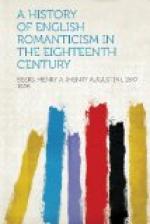The only important writer who had employed blank verse in undramatic poetry between the publication of “Paradise Regained” in 1672, and Thomson’s “Winter” in 1726, was John Philips. In the brief prefatory note to “Paradise Lost,” the poet of “L’Allegro” and “Il Penseroso,” forgetting or disdaining the graces of his youthful muse, had spoken of rhyme as “the invention of a barbarous age,” as “a thing trivial and of no true musical delight.” Milton’s example, of course, could not fail to give dignity and authority to the majestic rhythm that he had used; and Philips’ mock-heroic “The Splendid Shilling” (1701), his occasional piece, “Blenheim” (1705), and his Georgic “Cyder” (1706), were all avowed imitation of Milton. But the well-nigh solitary character of Philips’ experiments was recognized by Thomson, in his allusion to the last-named poem:
“Philips, Pomona’s
bard, the second thou
Who nobly durst, in rime-unfettered
verse,
With British freedom sing
the British song."[3]
In speaking of Philips’ imitations of Milton, Johnson said that if the latter “had written after the improvements made by Dryden, it is reasonable to believe he would have admitted a more pleasing modulation of numbers into his work."[4] Johnson hated Adam Smith, but when Boswell mentioned that Smith, in his rhetorical lectures at Glasgow University, had given the preference to rhyme over blank verse, the doctor exclaimed, “Sir, I was once in company with Smith and we did not take to each other; but had I known that he loved rhyme as much as you tell me he does, I should have hugged him.”
In 1725 James Thomson, a young Scotchman, came to London to push his literary fortunes. His countryman, David Malloch,—or Mallet, as he called himself in England,—at that time private tutor in the family of the Duke of Montrose, procured Thomson introductions into titled society, and helped him to bring out “Winter,” the first installment of “The Seasons,” which was published in 1726. Thomson’s friend and biographer (1762) the Rev. Patrick Murdoch, says that the poem was “no sooner read than universally admired; those only excepted who had not been used to feel, or to look for anything in poetry beyond a point of satirical or epigrammatic wit, a smart antithesis richly trimmed with rhyme.” This is a palpable hit at the stronger contrast than between Thomson and Pope, not alone in subject and feeling, but in diction and verse. Thomson’s style is florid and luxuriant, his numbers flowing and diffuse, while Pope had wonted the English ear to the extreme of compression in both language and meter. Pope is among the most quotable of poets, while Thomson’s long poem, in spite of its enduring popularity, has contributed but a single phrase to the stock of current quotation:




